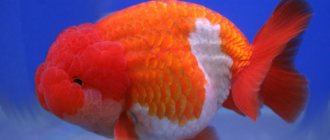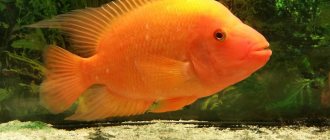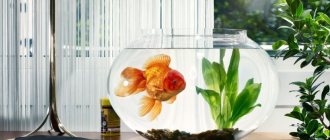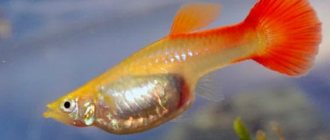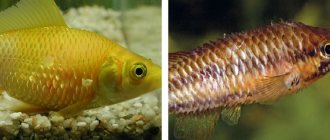Filomena or red-eyed moenkhausia (lat. Moenkhausia sanctaefilomenae), was once one of the most common tetras in the aquarium. A school of these characins can decorate and enliven any aquarium, but at the moment it has lost popularity to other fish.
Although the phylomena is not as bright as other tetras, it has its own charm.
Red eyes, a silvery body and a black spot near the tail, in general, do not make much of an impression, but together with the lively behavior they create an interesting fish.
And if you consider that they are quite unpretentious and easy to breed, then you get a good aquarium fish, even for beginners.
Just keep in mind that Philomena, like all tetras, loves to live in a school of 5 fish or more. For such a flock you need an aquarium of at least 70 liters, with open swimming areas.
Varieties and their differences
In the natural environment, there are many subspecies of phylomena, but only two of them are bred in aquariums:
- Philomena vulgare;
- phylomena Balloon (disc).
The appearance of the fish varies in size, and there are some peculiarities in their habits and behavior. For example, Philomena vulgaris swims in a not too dense flock, but Ballons live crowdedly, preferring to group in groups of 5-6 individuals. The disc phylomena has a more rounded body than the regular one. The Ballona fish is slightly longer than the common red-eyed tetra.
Both subspecies are not distinguished by aggressive behavior, therefore they coexist peacefully in an aquarium inhabited by fish of approximately the same size as them.
The average lifespan of fish is 3-5 years.
Veiltail - description
Veiltail goldfish has a characteristic egg-shaped shape, which makes it different from others. Because of such a body, the fish is not a fast swimmer, and often does not have time to get to food with lightning speed after other inhabitants of the aquarium. The tail of this fish is very long, forked, reminiscent of a light veil, which served as an aid for the name. When purchasing a new pet, many people are interested in the question: how long do veiltails live in an aquarium? This fish is one of the long-lived fish and, under good conditions, will live 10 years or longer.
The colors of this fish come in a variety of colors, so the main ones include:
- The golden veiltail
is the most sought after species.
Spotted
- each individual has a unique color.
Black veiltail telescope
– a rare and exclusive color of fish with large bulging eyes.
Milky white
– delicate with a pearly sheen.
What does a veiltail look like?
Once you know what a veiltail fish looks like, it’s difficult to put off purchasing it even for a moment. These aquarium inhabitants are very beautiful, have an oval shape, the line of the head smoothly passes into the body, and then into the back. The belly is round, slightly swollen. The tail is long, double, the size of which is several times larger than the body. The remaining fins are very long, translucent with slightly pointed borders. The dorsal fin is the size of half the body. The eyes are large and can be of different colors, except green. Under favorable conditions, the length of the fish reaches 20 cm.
Veiltail - how to distinguish a female from a male?
Sometimes determining gender can be problematic. Young representatives of the fish are generally identical, and they can be easily distinguished only during spawning. Characteristic features in the description of the veil-tail fish:
- The body of females in adulthood is larger and rounder, males are smaller in size.
- During sexual activity, males develop white pimples in the area of the pectoral fins and gills, which is when they are easiest to identify.
- When spawning, the males' front fins become jagged and saw-like.
- During spawning, females become rounded, acquiring a spherical shape.
- In males, the growth between the ventral and caudal fin is much larger, in females it is smaller or completely absent.
- The fins on the abdomen of the female are rounded and shorter than those of the males.
- “Ladies” are outwardly brighter and more active.
- If you introduce a new female to a school of goldfish, only the males will show interest in her.
Appearance of the red-eyed phylomena
The body of the fish is elongated and flattened on the sides. The common phyllomena is shaped like an ellipse. Filomena disk has rounded sides, so it looks like a balloon in shape. The fins of both subspecies are small and transparent, of a grayish tint. The fin, located in the tail, has two blades; at the base of the tail there is a transverse black stripe.
The color of the scales is silver. There are bright red spots above the eyes that stand out clearly against the rest of the background. A school of these fish can decorate a home aquarium. The back of moencausia has olive-green tints, and the silvery sides may appear yellowish in different lighting conditions. The body seems to be covered with a mesh. This darker edging of the scales creates the illusion of a reticulated pattern.
The upper area of the iris is distinguished from the rest of the eye by its red color. It seems that the female fish has painted her eyelids with red eye shadow. The length of the fish inhabiting the aquarium rarely exceeds 5 cm; in the natural environment, fish grow up to 7-10 cm. If we consider a pair, the female from the front appears fuller, and the male looks somewhat smaller and thinner.
HOW TO PROTECT YOURSELF
There are several ways to reduce the risks of peeling with Garra fish:
- Thorough self-examination. Take the time to check the skin at the treatment site to see if there are any wounds, suspicious plaques or spots on your legs. If you notice any warning signs, it is best to first consult a dermatologist.
- Checking the responsibility of establishment staff. If the salon does not examine you before the session for open wounds and skin infections, it is better to refuse treatment: this means that it is a common thing here to turn a blind eye to compliance with hygiene requirements.
- Insist on a pause after another client for 5-7 minutes so that the water passes through the filtration and sterilization system: this will destroy all fungi and ciliates. In a budget beauty salon, this requirement may seem inappropriate to you: well, so much the better. A salon that values its reputation will definitely make concessions, and you don’t need another.
- To distinguish Garra Rufa from fakes, there is a proven method. Make sure that the fish's mouth is below eye level and has a round (not pointy, like a chin-chin) shape. Additionally, you should not feel any pain during the pedicure. Other signs of a real Garra Rufa include a steel-colored body, a scarlet fin, and a desire to be in an empty pool closer to the bottom.
We recommend: What is FRACTIONAL LASER PEELING. Doctors comment
If you have verified the authenticity of your “exfoliation master” and have taken all precautions, the only advice: during the procedure, try not to make sudden movements so as not to scare the fish
Choice of neighbors
Despite the fact that the fish are non-aggressive, keeping them with veiled-tailed beauties will not work. Due to the increased interest in long fins and the great mobility of phylomena, veiled-tailed individuals may lose their beauty. Slow fish are also not suitable as neighbors for filomen. The increased activity of the latter causes stress in the clumsy fish.
The following can become excellent and friendly neighbors:
- zebrafish;
- barbs;
- chain catfish;
- rasboras;
- corridors;
- medium-sized cichlids that are not characterized by aggressive behavior;
- Ancistrus;
- acanthophthalmus (loaches).
If, due to inexperience, the aquarist acquired only a couple of filomenas, they will be timid and also aggressively attack their neighbors. Pack inhabitants develop their own hierarchy, their behavior becomes non-aggressive. Therefore, acquiring a small flock is preferable to keeping a pair.
Compatibility
In general, the red-eyed tetra is a peaceful fish. But there are a couple of nuances in her behavior with her neighbors. When philomena are small in size, they are shy and very shy, often afraid of their neighbors in the aquarium. But once they grow up, not a trace remains of their timidity. They may begin to terrorize smaller tankmates and rip off the veiled fins of slow-moving fish. For this reason, it is recommended to house them with proportionate, active fish, at the same time peaceful, but capable of repelling insolent tetras:
- A good neighbor for the phylomena will be other proportionate, mobile tetras: glass, ternetsia, congo.
- You can practice keeping with peaceful cichlids: Apistogramma, Flamingo cichlid and Meek's cichlid.
- Red-eyed tetras will look natural with lively swordtails.
- A flock of philomenas will not risk attacking large irises.
- Ancistrus will not only not pay any attention to red-eyed tetras, but will also eat up any leftover food from them.
- Tetras are not interested in shrimp.
It is not recommended to place red-eyed moencausia with slow-moving fish with veil fins, for example, goldfish or angelfish. You should also be careful with large cichlids - they will easily eat small tetras. Small fish, on the contrary, run the risk of being bitten by insolent fish.
But basically, compatibility issues are individual in nature and often depend on living conditions. Overpopulation of the aquarium and small flocks lead to aggression. The larger the group, the stricter the hierarchy, which captures all the attention of the fish. By the way, this approach is also applicable to Sumatran barbs - known bullies.
(Visited 299 times, 1 visits today)
Features of feeding
Philomena in nature feed on any available types of food. Therefore, there are no problems with choosing food for the aquarium. The fish happily eat both dry food and frozen, live food. You can purchase daphnia, bloodworms, brine shrimp, granulated food or flakes.
To enhance color, fish need nutritional supplements. Therefore, it is recommended to purchase special formulations for filomen at the pet store. To improve the viability of fish, feed containing plant components is also included in the diet.
Detailed breeding tips
Filomenas are egg-laying individuals, so there are no difficulties with breeding. Spawning can occur in pairs or in a common flock, so when purchasing, you must select at least 2-3 males and several females. The best option for reproduction is the same number of different-sex individuals.
To activate spawning, fish begin to be fed with live food. Since phylomena are not fish that care for their offspring, to monitor the progress of spawning, adult fish are placed in a separate aquarium - a spawning tank. It is filled with water that meets all technical characteristics for phylomena (pH 5.5-6.5, temperature – +27-28°C).
No decorations are needed to decorate the spawning tank. All you need is bottom plants with large leaves on which females will spawn, as well as a special lattice bottom. The eggs fall down through the holes in the lattice, which protects them from being eaten by adults. The spawning pair is deposited in the evening, and the entire laying process occurs in the morning. After the spawning process is completed, the parent pair is resettled back into the common aquarium.
The eggs, located in a separate aquarium, are shaded and the process is monitored daily. As soon as the larvae emerge from the eggs (after about 24-36 hours), it is necessary to add food to the water. The fry react poorly to dry and granulated food; they do not notice it. The best food is ciliates, Artemia nauplii, egg yolk, and then microworms.
It is advisable to feed the fry with live food from birth; to do this, chop the rotifers. If live food is not available at the time the fry appear, you can add the yolk of a chicken egg to the water. To do this, boil the egg, remove the yolk, then grind part of it with a small amount of aquarium water and pour it into the spawning tank. The fry really like yolk feeding, but it pollutes the water too quickly.
An alternative option could be yogurt; adding it does not spoil the water so quickly. A teaspoon of curdled milk is poured with boiling water, the coagulated protein is caught with a net, dropped into the spawning tank and shaken. The feed should crumble into tiny protein particles.
Another type of food is milk powder. To get it, you need to pour a little milk into a deep plate and place the plate in a water bath over a pan of boiling water. After the water has evaporated, powder will remain on the plate, which can be added to the aquarium with the fry. To obtain powdered milk you will have to spend several hours.
After 10-14 days, the fry grow up and are able to eat crushed dry food with herbal supplements. Feed is added often, but in small portions.
In an aquarium with fry, part of the water should be changed daily, adding approximately 10% of fresh, purified liquid.
The light for fry should not be too bright.
Contents of blue acara
There are several rules that should be taken into account in order to organize suitable conditions for your pets.
- Blue acara prefers spacious aquariums. Six individuals, reaching a length of up to 10 cm, can live normally in a container with a volume of 100 liters. An adult couple needs an aquarium of 150-180 liters.
- Acara fish are heat-loving animals, so the temperature of the liquid should be in the range of 23-28°C. If the value drops below 22°C, then this negatively affects the condition of the pets.
- To keep acara, it is necessary to equip the fish with shelters of the appropriate size. To decorate the aquarium, use large stones and driftwood. As for plants, you need to choose large and tough species, otherwise the fish will simply destroy them. You can use artificial plant analogues, but they must be well attached.
Blue cancers - care
In order for the fish to be healthy, look attractive and produce offspring, it is necessary to follow a number of recommendations:
Large blue loaches have a fast metabolism, so they spoil water a lot, which is one of the serious drawbacks, since it is important for them to live in clean water. To ensure this condition is met, powerful filters must be used. It is worth considering that neon blue acaras are sensitive to the effects of nitrates, so it is recommended to replace at least 30% of the water in the aquarium every week. In addition, it is important to clean the soil. In care, proper illumination is of great importance and the light should be of medium power
A suitable length of daylight is approximately 10 hours. At night, special night lamps can be used.
In addition, it is important to clean the soil. In care, proper illumination is of great importance and the light should be of medium power. Suitable daylight hours are approximately 10 hours
At night, you can use special night lamps.
Blue acara - feeding
Fish of this species are micropredators, so their diet must certainly contain live food, for example, bloodworms, tubifex, earthworms, shrimp and mussels. Aquarium acara fish should receive spirullina and vitamins in their diet. When choosing dry food, you should give preference to large granules and sticks. Give your pets food in small portions in the morning and evening.
It is important to consider that fish are prone to overeating, which causes digestive problems.
Blue Acaras - Reproduction
Puberty occurs when fish reach nine months of age. First, the pair finds a suitable substrate and cleans it. It is best to place a flat stone or slide in the aquarium for this purpose. The reproduction of blue acara is accompanied by an increase in aggression, which often leads to the fish eating the eggs. Both parents take care of the future partner; for example, they eat unfertilized eggs. The incubation period lasts 3-8 days and after 4 days you can start feeding the fry with starter food.
Blue acara – compatibility
Fish of this species love space and it is important for them to move freely around the aquarium, so you should not let many inhabitants into it. To understand the compatibility of cancers, it is necessary to take into account that these fish are aggressive, and they can constantly bully their “neighbors” to provoke a fight. It is best to choose a peace-loving pair for the aquarium and good compatibility is observed with catfish, ocellated astronotus, severum and so on
Do not add too large or small fish
It is best to choose a peaceful pair for the aquarium and good compatibility is observed with catfish, ocellated astronotus, severum and so on. You should not add fish that are too large or small.
Pisces Acara - diseases
If you neglect the rules of keeping, your sea pets can get sick and even die. Provoking factors include dirty water, poor-quality food, and sick “neighbors.” Acara cichlids are treated with special medications that should be purchased at veterinary pharmacies. For example, if the disease is caused by poisoning or food contamination, then it is necessary to take a course of antibacterial drugs that are added to the food.
Requirements for water and aquarium arrangement
Filomena belongs to freshwater inhabitants, so the aquarium must have appropriate water. The tropical regions of South America are quite warm, so water heated to +22-26°C is considered comfortable for philomena. During spawning, the water temperature is raised by 1-2°C.
Other water indicators necessary for the life and reproduction of fish:
- acidity within 6.5-7 units;
- hardness – no more than 15°.
Filtration is necessary, but the fish do not like too strong a current.
Tetraodon green, green pufferfish (Tetraodon fluviatilis)
[Total: 0 Average: 0/5]Habitat. Tetraodon green lives in brackish waters of Southeast Asia (India, Sri Lanka, Bangladesh, Burma, Indonesia).
Appearance and color. Tetraodon green has a pear-shaped body without scales. The body and head are covered with small spines, which in a calm state are adjacent to the body. In case of danger, the fish takes the shape of a ball, thanks to the air sac, and the spines become vertical. If you remove green tetraodon from water, it immediately swells, swallowing air. Released into the water, the tetraodon floats for some time inflated, belly up, and seems absolutely helpless. The eyes of this fish are large and mobile. The back is rounded and wide. The dorsal fin is shifted back, the caudal fin is rounded, and the ventral fin is absent altogether. The teeth merge with each other and form a pair of cutting plates in each jaw, which are separated in front. Tetraodon green has a yellowish-green color, the abdomen is light. The upper half of the body is covered with numerous black spots. With age, the body color of green tetraodon fades significantly.
Sexual characteristics. The male is smaller and brighter than the female.
Maintenance and feeding. Only a species aquarium of 200 liters or more is suitable for it, because it bites off the fins of other fish. The Pufferfish must be transported in a container made of hard material, otherwise it may bite or puncture the plastic bag. Tetraodon green stays in the lower and middle layers of water. Swimming areas should be alternated with areas that are densely planted with aquarium plants with large and hard leaves. It is desirable to have floating plants in the aquarium, as fish love partial shade. Water parameters for optimal content of green tetraodon: water hardness 7-12°, water acidity pH 7.0-8.0, water temperature 24-28 °C. Tetraodon tolerates fresh water well, but brackish conditions are still preferable for it. Filtration and monthly replacement of up to 1/3 of the aquarium volume are required. Tetraodon feeds on any live food, but snails are a special treat for it. Vegetable and meat supplements in the form of sinkable tablets are also needed. Life expectancy in an aquarium is about 9 years. Tetraodon green can grow up to 15-17 cm in length.
Breeding and reproduction. Tetraodon green reaches sexual maturity by 2 years. Breeding in captivity is rare. For breeding, a spawning tank with a volume of 100 liters or more with shelters and thickets of hard-leaved plants is taken. Lighting should be diffused. The water parameters during spawning are as follows: water hardness 10-20°, water acidity pH 7.0-7.5, water temperature 25-28 °C. You must add table or sea salt to the water (30 tablespoons per 100 liters of water). The female lays up to 300 eggs on smooth stones. After spawning, the female is removed, and the male remains to take care of the offspring. The incubation period lasts from 3 to 7 days. Starter food: live dust.
Behavior in the aquarium. Predatory fish, only a species aquarium is required.
Aquarium dimensions
If you plan to purchase a small flock of 5-6 individuals, it is enough to buy a rectangular aquarium with a capacity of 70 liters. The more individuals you plan to buy, the larger the vessel for them should be.
Special diffuser lamps will help highlight the unusual color and red spots above the eyes. They will create the illusion of a reddish glow from the lanterns. The silvery color of the fish is well set off by the dark soil.
The perimeter of the bottom of the aquarium should be densely planted with algae plants. Plants floating on the surface of the water help create diffused lighting. For the same purpose, you can throw dry leaves into the aquarium.
Necessary equipment and decorations for an aquarium
The lighting for an algae aquarium should not be too bright, otherwise the plants will grow too quickly, which will require regular cleaning of the bottom. The fish are active during the daytime, so at night the lights are turned off or the aquarium is illuminated with a dim lamp.
Some types of lighting fixtures can heat water, which can adversely affect the inhabitants, because differences in day and night temperatures will be significant. To prevent this from happening, it is advisable to buy fluorescent lamps; they do not heat the water so much, but at the same time they highlight the colors of the fish well.
It is best to fill the bottom with small pebbles, making a slight slope from the back wall to the front.
Then decorations and plants are placed. Decorations should be placed before water is filled into the aquarium.
The choice of filter system is made taking into account the volume of water in the aquarium and the appropriate cost. After the filter is installed and the aquarium is filled with water, check the functionality of the filter. 2-3 minutes after turning on the device, water should circulate evenly without creating excessive noise.
An important indicator for an aquarium is the water temperature. To measure it you will need to purchase a special thermometer. They come in alcohol, mercury, electronic, spiral, liquid crystal, strip-shaped, etc. Their cost depends on the accuracy of the measurement and the type of fastening, as well as the presence of a warning system, which some thermometers are equipped with. Place the thermometer on the wall opposite the heater, approximately in the middle thickness of the water. Please note that lamps can distort temperature readings.
Another necessary accessory is a heater. Without it, it is very difficult to maintain the required temperature, especially in winter. Heaters must be selected according to power and be sure to pay attention to the presence of a thermostat. This will help maintain the required temperature in the aquarium.
An electronic pH meter will help you monitor the acidity level of the water. Modern manufacturing companies have greatly simplified the life of aquarists by producing special devices with a carbon dioxide reactor. They work around the clock and maintain a given acid-base balance.
Proper arrangement of the aquarium will create a cozy corner in the house not only for the fish, but also for all family members. After all, not only children love to watch the life of the underwater world while sitting on a comfortable sofa.
Fish diseases
Wild representatives of this species are distinguished by their endurance, but over the years of selection, many breeds and hybrids on sale have become weakened and susceptible to disease. This especially applies to the popular Black Molly.
The only way to reduce the likelihood of disease outbreaks is to keep the fish in a suitable habitat. Too low temperatures, sharp and frequent fluctuations in pH and dGH values, poor nutrition, etc. have a depressing effect on the immune system, which can provoke one or another disease. Read more about symptoms and treatment methods in the section “Diseases of aquarium fish”.





